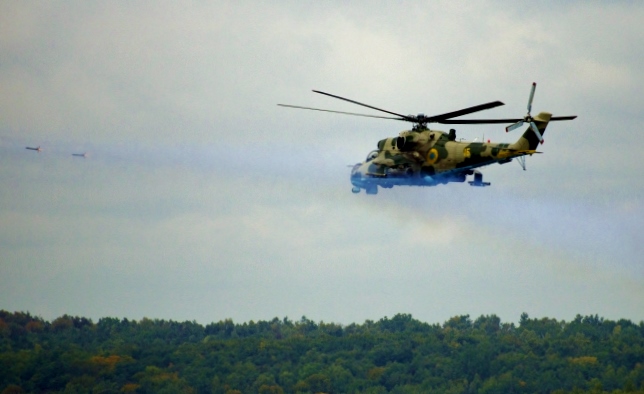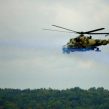
Ukraine Conducts Aggressor Response Exercise Amidst Tensions with Russia
Publication: Eurasia Daily Monitor Volume: 10 Issue: 182
By:

Ukraine’s President Viktor Yanukovych inspected the Army and Air Force’s performance as commander-in-chief at the Yavoriv military and peacekeeping training center in Lviv oblast on October 1. The website of the Ukrainian Ministry of Defense (accessed October 6) reported that the purpose of the year-end tactical demonstration exercise was to examine the command and control (C2) performance of the Army, as well as to observe the Airborne and Air Force units practicing responding to a military conflict at the border. Illustratively, Kommersant-Ukraine entitled its October 2 article covering the exercises as: “The Military Rehearsed the Response to Foreign State’s Aggression” (www.kommersant.ua/doc/2310037). The articulation of the scenario as a response to aggression by a foreign state, combined with President Yanukovych’s attendance at the exercise, makes this otherwise routine drill special. The exercise did not make any overt references to Russia. But politically, it was a demonstration of the Ukrainian defense system’s readiness at a time of growing Russian pressure (see EDM, October 10), as Kyiv prepares to sign the Association Agreement with the European Union on November 28–29.
The military maneuvers carried out at Yavoriv, Ukraine’s most advanced international firing range and training center, involved 1,700 troops from the Army and 400 units of equipment, including Su-25 aircraft, Mi-24 helicopters, tanks, artillery and anti-tank missile launchers. Lviv-based Ukrainian news channel “24” reported that the scale of the two-hour exercise, as compared to the past five years, was unprecedented for the Yavoriv range. The drill involved troops deployed from several regions of western Ukraine. The exercise simulated the detection of an intruder by reconnaissance aircraft armed with infrared surveillance equipment; an armed response that included bombing, anti-tank warfare and artillery support; and, finally, the deployment of Airborne troopers from helicopters to provide a physical response on the ground (https://lviv24.com/home/showSingleNews.do?na_yavorivskomu_poligoni_vidbulis_navchannya_za_uchastyu_prezidenta&objectId=80014). President Yanukovych, dressed in a stylish civilian coat, himself fired a Ukrainian-made Stugna-P anti-tank missile.
Although the October 1 exercise did involve the participation of soldiers on the ground, its primary objective was to test the Ukrainian military’s command-and-control systems. This explains the exercise’s relatively small scale. Ihor Koziy, a military analyst at the Kyiv-based Institute of Euro-Atlantic Cooperation, told Jamestown on October 2 that 1,700 troops does not even comprise a full enforced infantry regiment. In fact, the drill was a routine activity that the Ukrainian armed forces conduct regularly to wind up the year’s training schedule. But President Yanukovych’s personal inspection of the exercise provided it with significant political weight. Most likely, by just being there, the president’s message was to promote Ukraine’s defense sector reform to the domestic audience. But in the context of the recent tense bilateral relations with Russia, as Ukraine prepares to enter the EU Association Agreement, the drill was also meant to demonstrate Ukraine’s military readiness. This notion is further strengthened by the fact that the Ukrainian exercise was conducted just after Russia held its large-scale Zapad (“West”) 2013 drills jointly with Belarus (see EDM, October 4, 9).
The tensions with Russia have been growing, and feelings of a Russian threat are presently rather strong in Ukraine. And this time, the word “threat” was uttered by Viktor Yanukovych himself when he was interviewed by Bloomberg on September 25—albeit in diplomatically alluding to the media’s coverage of Moscow-Kyiv relations (https://www.bloomberg.com/news/2013-09-24/yanukovych-sure-on-eu-pact-as-ukraine-braces-for-russia-backlash.html). Russia’s threats to Ukraine are economic and political. But their intensity and persistence raise the question of whether such pressure, coupled with Vladimir Putin’s military bravado, signals Russia’s capability to use force against Ukraine at some point.
A provocative interview by Russian journalist Arkady Mamontov has alleged that Ukraine is concentrating its troops near the Russian border; but the “evidence” Mamontov presents in the article is apparently unsubstantiated (https://www.segodnia.ru/content/18709). Rather, the Russian Black Sea Fleet, which, by bilateral agreement, is stationed in Sevastopol on Ukraine’s Crimean peninsula, might be a source of new problems between the two countries. On October 5, the influential Ukrainian paper Dzerkalo Tyzhnya alerted readers that Russia was allegedly modernizing some of the Black Sea Fleet equipment, including an armored personal carrier and some small boats, without Ukraine’s consent (https://gazeta.zn.ua/international/perevooruzhenie-ispodtishka-_.html). Ukrainian defense expert Valeriy Badrak mentioned on August 22 that the Russian Black Sea Fleet base “is a destabilizing factor and under certain circumstances might constitute a threat… [T]hese [Russian] units may be used in a context that would threaten Ukraine’s integrity and independence” (https://inpress.ua/ru/politics/15018-gotovitsya-k-masshtabnoy-voyne-ni-s-nato-ni-s-rossiey-ukraina-ne-smozhet-valentin-badrak).
Ukrainian and Russian experts generally believe that military conflict between the two countries is unlikely for now. While speaking to Jamestown (October 2), Ihor Koziy denied any connection to Russia in the October 1 Yavoriv drills. And Valeriy Badrak noted that “Russia was not interested, thus far, in a military conflict” (https://inpress.ua/ru/politics/15018-gotovitsya-k-masshtabnoy-voyne-ni-s-nato-ni-s-rossiey-ukraina-ne-smozhet-valentin-badrak). Whereas, the executive editor of the Russian military publication Nezavisimoye Voyennoye Obrozreniye, Viktor Litovkin, told Jamestown on October 4, “A Ukrainian-Russian military conflict is just unthinkable.” Litovkin did agree that there might be “provocations” in Crimea, but he argued Ukraine will seek a resolution to any conflicts that explode using the police rather than its armed forces.
Nevertheless, it seems that the current negative political trend in bilateral relations is worrisome for Ukrainians. Over the past several months, Moscow’s numerous sharp and emotional statements against Ukraine entering into an Association Agreement with the EU were coupled with a Russian blockade on a range of Ukrainian exports (see EDM, August 15, September 3). And a more recent, brief silence by Russian officials, which suggested Moscow’s rethinking of its own strategy, has again been replaced by adamant warnings against Ukraine’s pro-Western course. Speaking on October 8, President Vladimir Putin asserted that Ukraine and Russia were “one nation” and cautioned that Kyiv’s signing of the Association Agreement would lead to Russia being “forced to take defensive [economic] measures” (see EDM, October 9; https://www.kremlin.ru/transcripts/19382). The closer Kyiv comes to the November summit with the EU, the hotter Moscow’s rhetoric will grow, and the more provocative its actions are likely to become.




